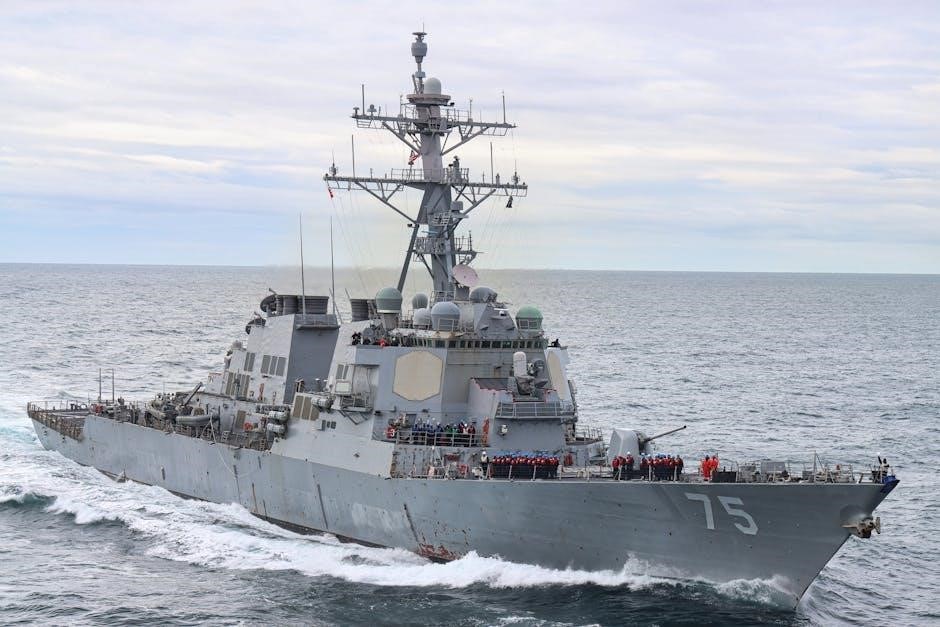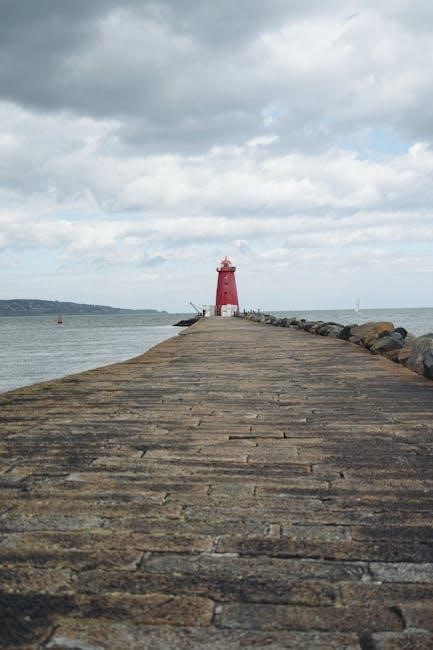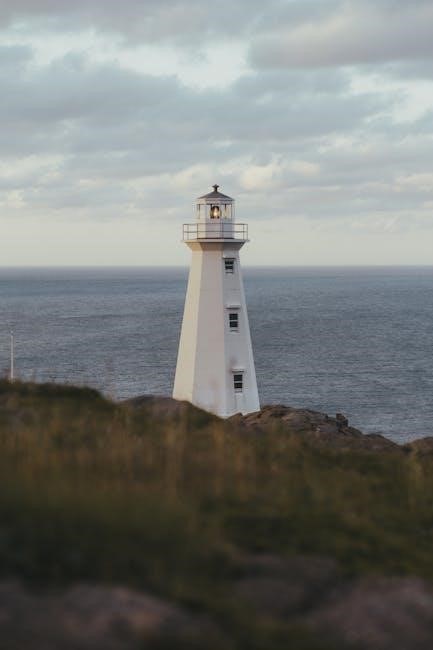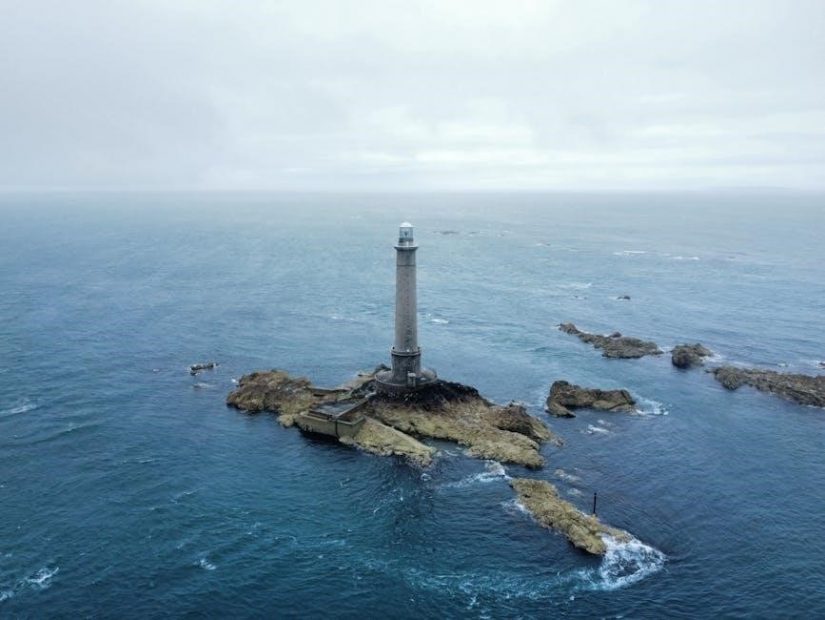Rosemount Guided Wave Radar (GWR) is a advanced level measurement technology using microwave pulses for accurate, reliable, and maintenance-free monitoring in liquids, slurries, and solids․
1․1 Overview of Guided Wave Radar Technology
Guided Wave Radar (GWR) uses microwave pulses traveling along a probe to measure levels in liquids, slurries, and solids․ It operates by detecting reflected waves from the medium’s surface, providing accurate and reliable measurements․ This technology excels in challenging environments, such as high pressure, extreme temperatures, and boiling hydrocarbons, making it ideal for industries like oil and gas․ Rosemount’s GWR solutions, including the 5300 and 3300 series, ensure minimal maintenance and high performance in demanding applications․
1․2 Basic Principle of Operation
Guided Wave Radar operates by transmitting microwave pulses along a probe, which reflect off the surface of the measured medium․ The time difference between the transmitted and reflected waves determines the level․ The technology relies on the dielectric constant of the medium, with higher constants yielding stronger reflections․ It accurately measures both level and interface, ensuring reliable performance in challenging conditions like high pressure, turbulence, and boiling liquids․

Rosemount 5300 Series Guided Wave Radar
The Rosemount 5300 Series is a high-performance guided wave radar transmitter designed for level and interface measurements in challenging applications, including liquids, slurries, and solids․
2;1 Features and Capabilities of the Rosemount 5300
The Rosemount 5300 offers advanced features like high accuracy, no moving parts, and minimal maintenance․ It handles challenging applications, including boiling hydrocarbons, with a large coaxial probe design for solids and slurries․ Its state-of-the-art signal processing ensures reliable measurements, and it supports both level and interface detection, making it versatile for various industrial needs․
2․2 Applications of the Rosemount 5300 in Challenging Environments
The Rosemount 5300 excels in challenging environments, such as high-pressure and high-temperature applications․ It is ideal for measuring liquids, slurries, and solids, including boiling hydrocarbons․ Common applications include oil and gas production tanks, separator tanks, and process vessels with difficult media․ Its robust design ensures reliable performance in extreme conditions, making it a versatile solution for demanding industrial environments;
Rosemount 3300 Series Guided Wave Radar
The Rosemount 3300 Series offers versatile, field-proven level measurement solutions for liquids, semi-liquids, solids, and interfaces, ensuring reliability with minimal maintenance and no moving parts․
3․1 Key Features of the Rosemount 3300 Series
The Rosemount 3300 Series features advanced guided wave radar technology, offering accurate level and interface measurements․ It supports various media, including liquids, semi-liquids, and solids, with minimal maintenance requirements․ The series includes models like the 3301 and 3302, which provide field-proven reliability and versatility․ These transmitters are designed for challenging applications, ensuring consistent performance across different industries and process conditions without the need for frequent recalibration or complex setup․
3․2 Industries Served by the Rosemount 3300 Series
The Rosemount 3300 Series serves diverse industries, including oil and gas, chemical processing, food and beverage, and power generation․ Its versatility makes it ideal for applications in challenging environments, ensuring accurate level and interface measurements in liquids, semi-liquids, and solids․ This technology supports process control and safety functions across various industrial sectors, delivering reliable performance in demanding conditions․

Guided Wave Radar for Level and Interface Measurement
Guided Wave Radar uses microwave pulses for precise level and interface measurement in liquids, slurries, and solids, ideal for challenging industrial applications․
4․1 How Guided Wave Radar Measures Level
Guided Wave Radar measures level by transmitting microwave pulses through a probe․ The waves reflect off the medium’s surface, with the time delay between transmission and reflection determining the level․ The dielectric constant of the medium affects reflection strength, enabling accurate measurement in liquids, slurries, and solids․ This technology ensures high accuracy and reliability with minimal maintenance․
4․2 Interface Measurement with Guided Wave Radar
Guided Wave Radar measures interface levels by detecting the dielectric contrast between two media․ The transmitter sends microwaves down a probe, reflecting off the interface․ The residual wave from the first reflection is used to determine the interface level, enabling accurate measurement in applications like separator tanks․ This technology excels in challenging environments, providing reliable interface data for process control and optimization․

Applications in the Oil and Gas Industry
In the oil and gas industry, Rosemount Guided Wave Radar is used for measuring hydrocarbons and water in production and separator tanks, ensuring reliable and accurate level monitoring․
5․1 Measurement of Hydrocarbons and Water in Production Tanks
Rosemount Guided Wave Radar accurately measures hydrocarbons and water levels in production tanks, even in remote locations․ Its reliability ensures minimal maintenance and precise monitoring, crucial for optimizing production and safety in challenging environments with varying process conditions․
5․2 Use in Separator Tanks for Level and Interface Measurement
Rosemount Guided Wave Radar excels in separator tanks, providing precise level and interface measurement between hydrocarbons and water․ Its microwave-based technology ensures accurate readings despite challenging conditions, such as emulsions or foam․ Reliable operation with no moving parts minimizes downtime, while advanced signal processing enables clear distinction between phases, optimizing separation efficiency in oil and gas production․
Case Studies and Success Stories
Rosemount Guided Wave Radar has proven its effectiveness in real-world applications, eliminating unscheduled shutdowns in a confectionery plant and improving efficiency in high-pressure environments․
6․1 Eliminating Unscheduled Shutdowns in a Confectionery Plant
A confectionery plant faced frequent shutdowns due to inaccurate level measurements․ By implementing Rosemount Guided Wave Radar, they achieved reliable, maintenance-free monitoring, eliminating downtime and improving production efficiency significantly․
6․2 Improved Plant Efficiency in High-Pressure Applications
The Rosemount 5300 Guided Wave Radar significantly enhanced efficiency in high-pressure environments by providing precise level measurements․ Its robust design handles extreme conditions, ensuring accuracy and reliability․ Plants experienced reduced downtime and increased production throughput․ The technology’s minimal maintenance requirements further contributed to operational efficiency, making it a preferred solution for challenging industrial applications․
Technical Specifications and Probe Design
Rosemount Guided Wave Radar features advanced probe designs, including Probe End Projection and Large Coaxial Probes, enhancing reliability in solids, slurries, and challenging liquid applications․
7․1 Probe End Projection for Enhanced Reliability
The Probe End Projection in Rosemount Guided Wave Radar ensures accurate level measurements by minimizing interference from internal vessel structures, improving signal clarity, and reducing measurement errors in challenging environments․
7․2 Large Coaxial Probe Design for Solids and Slurries
The Rosemount Guided Wave Radar’s large coaxial probe design excels in solids and slurries, offering enhanced reliability․ Its robust construction minimizes clogging and ensures accurate measurements in dense materials․ The probe’s durability reduces maintenance needs, making it ideal for challenging industrial applications․
Accuracy and Reliability in Various Media
Rosemount Guided Wave Radar ensures high accuracy and reliability across liquids, slurries, and solids, delivering consistent performance in challenging applications like boiling hydrocarbons and dense materials․
8․1 Performance in Liquids, Slurries, and Solids
Rosemount Guided Wave Radar excels in measuring liquids, slurries, and solids with high accuracy and reliability, even in challenging conditions․ Its robust design ensures consistent performance across varying media, from viscous slurries to dense solids, while handling boiling hydrocarbons and other difficult liquids effectively․ The technology’s ability to adapt to diverse process conditions makes it a versatile solution for industrial level measurement needs, ensuring precision and durability in demanding environments․
8․2 Handling Boiling Hydrocarbons and Difficult Liquid Applications
Rosemount Guided Wave Radar is specifically designed to handle boiling hydrocarbons and challenging liquid applications with ease․ Its advanced signal processing and robust probe design ensure accurate level measurements even in turbulent or high-temperature conditions․ The technology minimizes interference from steam or vapor, providing reliable performance in applications where traditional methods often fail, ensuring operational efficiency and safety in demanding industrial environments․
Maintenance and Calibration
Rosemount Guided Wave Radar requires minimal maintenance due to its no-moving-parts design, ensuring long-term reliability․ Calibration is straightforward, with quick procedures to ensure accuracy and performance consistency․
9․1 Minimal Maintenance Requirements
Rosemount Guided Wave Radar systems require minimal maintenance due to their robust design and absence of moving parts․ This ensures long-term reliability and reduces downtime, making them ideal for challenging industrial environments․ The lack of mechanical components eliminates wear and tear, while the simple calibration process ensures consistent accuracy without frequent interventions, optimizing plant operations and safety․
9․2 Calibration Procedure and Best Practices
The calibration of Rosemount Guided Wave Radar transmitters involves setting the security jumper, trimming the analog output, and adjusting zero and span values for accuracy․ Following best practices ensures reliable measurements․ Regular verification of settings and adherence to manufacturer guidelines are recommended to maintain optimal performance and precision in level and interface applications․

Comparison with Other Level Measurement Technologies
Rosemount Guided Wave Radar offers superior reliability and accuracy compared to mechanical and ultrasonic systems, excelling in challenging environments with minimal maintenance requirements․
10․1 Advantages Over Mechanical and Ultrasonic Systems
Rosemount Guided Wave Radar offers superior reliability and accuracy compared to mechanical and ultrasonic systems, excelling in challenging environments with minimal maintenance requirements․ Unlike mechanical systems, GWR has no moving parts, reducing wear and tear․ It also outperforms ultrasonic devices in turbulent or high-pressure conditions, providing consistent measurements․ Additionally, GWR can handle boiling hydrocarbons and difficult liquids, making it ideal for demanding applications where other technologies fall short․ Its ability to measure both level and interface further enhances its versatility․ With no recalibration needed and minimal maintenance, GWR delivers long-term efficiency and cost savings․
10․2 Limitations and When to Use Alternative Technologies
While Rosemount Guided Wave Radar excels in many applications, it may face limitations in environments with dense solids or highly viscous liquids, where signal strength can weaken․ Additionally, heavy foam or steam can interfere with measurements․ In such cases, alternative technologies like ultrasonic or capacitive systems might be more suitable, depending on the specific process requirements and media characteristics․ Understanding these limitations is key to selecting the right solution․

Industry Trends and Market Growth
The guided wave radar market is growing rapidly, driven by increasing adoption in process industries for accurate and reliable level measurements, with Emerson leading innovations and deployments․
11․1 Increasing Adoption in Process Industries
The adoption of guided wave radar technology is rising rapidly across process industries due to its accuracy, reliability, and minimal maintenance requirements․ Industries like oil and gas, chemical, and power are increasingly leveraging this technology for level and interface measurements․ Its ability to perform in challenging environments, such as high-pressure and high-temperature applications, makes it a preferred choice for ensuring operational efficiency and reducing downtime․
11․2 Role of Emerson in the Guided Wave Radar Market
Emerson, through its Rosemount brand, is a leading innovator in guided wave radar technology․ By offering high-performance products like the Rosemount 5300 and 3300 series, Emerson has set benchmarks for accuracy and reliability in level and interface measurements․ Their commitment to advancing radar technology ensures they remain at the forefront of the market, driving adoption across various industries and applications․
Safety and Compliance
Rosemount guided wave radar systems prioritize safety with intrinsic design features and certifications, ensuring compliance with industrial standards for hazardous environments and reliable operation․
12․1 Safety Features of Rosemount Guided Wave Radar
Rosemount’s guided wave radar systems incorporate advanced safety features, including explosion-proof designs and intrinsic safety certifications, ensuring safe operation in hazardous environments․ These features minimize risks and comply with global safety standards, providing reliable performance without compromising worker safety or plant integrity․
12․2 Certifications and Approvals for Industrial Use
Rosemount Guided Wave Radar systems hold various certifications, including ATEX, IECEx, and CSA, ensuring compliance with global industrial standards․ These approvals validate their suitability for use in hazardous areas, providing assurance of reliability and safety across diverse industrial applications․
Rosemount Guided Wave Radar offers unmatched accuracy and reliability, making it a leader in level measurement․ Future advancements promise enhanced performance and expanded applications․
13․1 Summary of Key Benefits
Rosemount Guided Wave Radar offers exceptional accuracy, reliability, and minimal maintenance, making it ideal for challenging level and interface measurements․ Its versatility across liquids, slurries, and solids, combined with advanced signal processing, ensures precise results in harsh conditions․ The technology’s non-contact design eliminates moving parts, reducing wear and tear, while its robust probe designs enhance reliability in demanding applications, ensuring optimal performance and safety across industries․
13․2 Future Developments in Guided Wave Radar Technology
Future advancements in Rosemount Guided Wave Radar will focus on enhanced accuracy, versatility, and integration with industrial IoT․ Emerson is expected to expand GWR applications, improving performance in extreme conditions and offering real-time data analytics․ These innovations will solidify GWR as a leading choice for level and interface measurements, driving efficiency and reliability across diverse industries․
